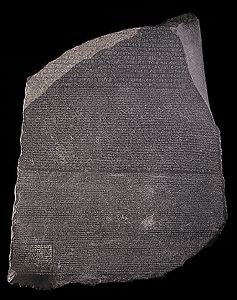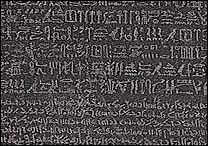The Rosetta Stone
Champollion's efforts to decipher the meaning of hieroglyphs.
 The Rosetta Stone - a sizable block of dark grey-pinkish
granodiorite stone bearing inscriptions written in three scripts - hieroglyphs (at top),
demotic (middle section), and greek (lower section) - has an immense significance in the history of archaeology and
in the better understanding
of ancient cultures.
The Rosetta Stone - a sizable block of dark grey-pinkish
granodiorite stone bearing inscriptions written in three scripts - hieroglyphs (at top),
demotic (middle section), and greek (lower section) - has an immense significance in the history of archaeology and
in the better understanding
of ancient cultures.
The tides of history that had impacted upon Egypt since the times of the Pharaohs - Greek, Roman, Christian,
Islamic and Arab, - had resulted in
a complete loss of insight into what the ancient Hieroglyphs, (the Greek word hieroglyphica means
"sacred carvings"),
actually represented in
terms of their intended meaning. The
demotic script was also very poorly understood.
The Rosetta Stone dates from 196 B.C. and was made available to
western science after 1799 A.D. when forces under the overall direction of the French leader Napoleon Bonaparte, were
pursuing his objectives in Egypt
The french involvements in Egypt in these times included the establishment of
a scholarly Institut de l'Égypte in Cairo which was staffed by many french scientists and archaeologists.
The Rosetta Stone
arrived at the Institut de l'Égypte in August 1799 after some french soldiers had discovered it whilst rebuilding a
fort at Rashid,
(hence Rosetta), in the Nile Delta.
From the time of its discovery the Rosetta Stone was regarded as having the potential for yielding a better
understanding of what some hitherto little understood script characters were intended to represent and it was
eventually proved to be the case that the Hieroglyphic, Demotic, and Greek inscriptions were intended to
convey the
same content of meaning in two
languages - Egyptian and Greek.
We now know that the Rosetta Stone bears a governmental decree written for the attention of the people of the city of Memphis.
At the time of this decree Egypt was ruled by a member of the dynasty, of greek origin, that was descended from Ptolomy
who had been one of Alexander the Great generals when that notable figure in history had led forces that had conquered Egypt.
This greek "hellenisation" of Egypt then gave scope for several scripts and languages to be current in
Egypt.
Hieroglyphs were traditionally used, since ancient times in the Egypt of the Pharaohs, for religious documents
and other important communications, Demotic Egyptian was the common script of Egypt,
and Greek had been established by the dynasty of rulers descended form Ptolomy.
The closing years of the eighteenth century were times of war between European powers and the Rosetta Stone
fell into English possession and this
resulted in its being lodged in the British Museum in 1802.

.gif)
|
|
Detail of hieroglyphic and demotic script on the Rosetta Stone. | |
It was only in 1822 that the great
French linguist and egyptologist Jean-François Champollion, who could read both Greek and Demotic text,
achieved really important insights into
the comparative translation of the scripts incised
into the stone laying the secure foundation for fulfilling its immense potential in assisting in the actual
understanding many previously
undecipherable examples of hieroglyphic writing.
Coptic was the language used by the Coptic church of Egypt from as early as the fourth century A.D.
It was also written with the Greek alphabet
but it utilizes seven additional symbols from the demotic script in order to cater for an additional
range of sounds used in egyptian speech.
Champollion, looking at how the seven traditional demotic signs were used in coptic, was able to work out
what they stood for.
Then he began tracing these demotic signs back
to hieroglyphic signs. By working out what some hieroglyphs stood for, he could make educated guesses
about what the other hieroglyphs stood for.
|
|
![[rosetta stone]](../local/enlightenment.gif)
![[rosetta stone]](../local/enlightenment.gif)